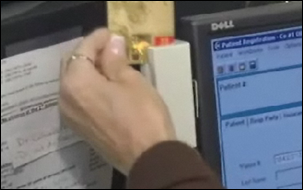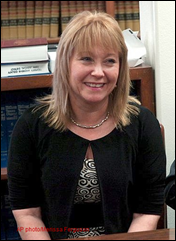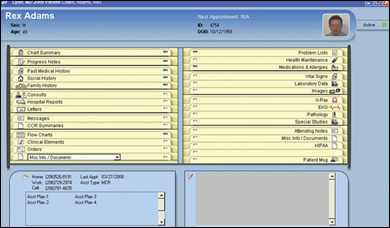Help wanted: would you please take a few moments to complete our HIStalk Practice Reader Survey? Your input is appreciated and will help us figure out what we are doing right and what we need to tweak. Mr. H told me I should beg for participants, which sort of reminded me of my days working for a vendor. Twice a year, the company would have employees indentify happy customers and then plead with a few to complete a KLAS survey. I’m pretty sure a lot of the execs had bonuses tied to KLAS scores, leading me to to wonder what kind of back-scratching went on with certain big-wig customers. We have don’t have bonuses or back-scratching, but we would be mighty appreciative if you’d take the time to give us your feedback. Thanks.
Siemens says it will continue re-selling NextGen’s PM/EMR products to its customers. The news came the same day NextGen officially shared word of its Opus Healthcare acquisition (which we actually mentioned one day earlier, thanks to a reader’s tip).
MacPractice releases version 3.7 of MacPractice MD, MacPractice DeC, and MacPractice 20/20 with MacPractice EMR. The EMR software now includes the ability to create lab requisitions and track results.

As more physicians adopt point of care payment technologies, look for consumer advocates to raise concerns about liability in the event of incorrect charges. A Kalamazoo, MI paper describes the mPay Gateway service just installed at four area practices. Using mPay Gateway’s system, the practices calculate a patient’s financial responsibility at the point of care, and automatically bill the patient’s credit card once insurance pays. One of the office manager claims the service provides, “greater transparency and peace of mind for the patient.” However, a follow-up op-ed piece suggests there needs to be some sort of safety net to provide patients financial protection in the event a provider or insurance company screws ups and bills a patient incorrectly.

Emdeon CEO George Lazenby shares some thoughts on the use of technology to reduce healthcare fraud and says that the automation of payment processes could save the US could save $30 billion annually. He also mentions this odd fraud case: a doctor’s wife works in her husband’s office until the two became estranged. After the separation, the wife she starts filing fraudulent insurance claims that name her ex as the provider. One hundred and eighty thousand dollars later, someone figures out the scheme and she is caught. Was she motivated by greed? Or, she was a woman scorn and scheming to get her ex in hot water?
Bad news if you are a hospital-associated outpatient doctor hoping to qualify for ARRA meaningful use incentives. The Senate ended up stripping those provisions from the HIRE Act, though it may be addressed in other bills.
A pharma-sponsored survey concludes that physicians are more likely to report drug side effects through an EHR than paper methods. Of the 300 surveyed physicians, half of all the docs and 60% of the full EHR users said they’d be much more likely to submit information about adverse events using an EHR system.

HHS Secretary Kathleen Sebelius and Labor Secretary Hilda Solis continue to hand out HITECH ARRA money, including $1 billion last week for HIEs, Regional Extension Centers, and job training. Forty states and State Designated Entities will receive $386 million to facilitate HIEs at the state level; $375 million will facilitate the development of 32 RECs to train 100,000 providers and hospitals in HIT over the next two years. The $227 million balance will be used to train 15,000 in healthcare, IT and other high growth fields.
A physician posts an editorial in the Wall Street Journal, noting that the “problem with the technology is simple: Doctors and nurses use it to communicate with insurers, not with each other.” The doctor points out that EHRs are designed to tell insurance companies that a physician fulfilled criteria to bill for a service but, that doesn’t translate into better care. He concludes:
If electronic records are only used to optimize billing and improve chart audits, patients will see little benefit. I doubt my patients received better care from the change. Electronic records can only play a supporting role in a broader effort to change our troubled system. Until our health care system imagines patients as more than grist for billing, I will happily take my chances with a colleague’s inscrutable scrawl over a phone-book-sized stack of computer printouts.
The current issue of Infectious Diseases in Children asks if pediatricians are ready to go paperless — and then provides a number of solid nuggets to ponder, regardless of specialty. In addition to providing all the compelling reasons for an EMR, the article explores some of the possible challenges: poor implementation, high initial costs, lower income due to lower patient loads during transition, and adjusting workflow to accommodate the EHR. Despite the difficulties, longtime EHR users believe it’s a “huge error” to wait on industry change.

The Texas nurse who was fired and charged with “misuse of official information” for confidentially reporting concerns about a perpetually trouble-prone doctor to the state’s medical board is acquitted. The jury took less than an hour to dismiss the case, with the jury foreman saying, “We don’t feel that what she did was wrong because she had concern for the patients. Nurses are the eyes for the patient.” The nurse and a colleague who was fired over the same incident are now considering adding another claim to their lawsuit against the doctor, hospital, sheriff, and prosecutor: malicious prosecution. Reports are suggesting that the doctor not only peddled quack vitamins, but that perhaps also had previously hired as one of his salespeople the sheriff who went after the nurse.

E-mail Inga.
















The article about Pediatric Associates in CA has a nugget with a potentially outsized impact: the implication that VFC vaccines…